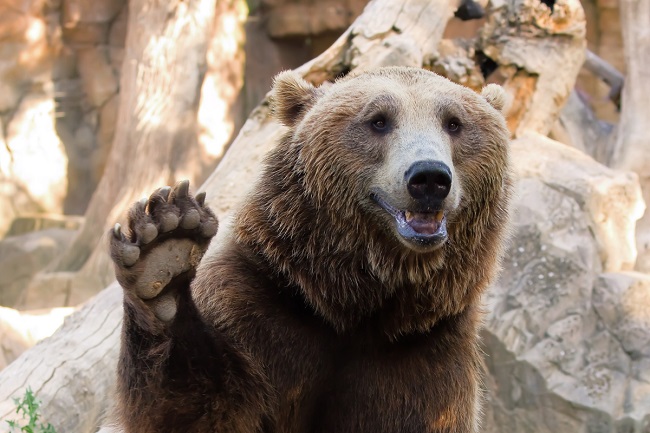There is an allure surrounding the idea of owning a ‘pet bear,’ often fueled by viral videos of cute bear cubs or bears displaying seemingly human-like behaviors. However, it’s important to dispel the myth and bring to light the reality of bear ownership.
In this article, we’ll dive into different bear species and explain why keeping them as pets is neither feasible nor ethical. While the term “breeds” is commonly used to describe different types of domestic animals like dogs or cats, it’s not typically used for wild animals like bears.
However, there are various species of bears, each with their unique characteristics. Here’s more information about the eight bear species.

Some Breeds of Pet Beers
Here are some of the common breeds of pet beers:
Read Also:
1. Brown Bear (including Grizzly Bear)
Brown bears are one of the most adaptable and widespread bear species, found across North America, Europe, and Asia. Their diet is omnivorous, with their meals consisting of berries, plant roots, small mammals, fish, and large mammals.
The Grizzly bear is a North American subspecies of the brown bear, recognized by its distinctive hump on its shoulders and its size, smaller than its coastal relatives but larger than black bears.
2. Polar Bear
The polar bear is the world’s largest land predator. Known for their distinctive white coats, these bears are superbly adapted to life in the Arctic, with a body built for cold temperatures, for swimming in cold water, and hunting seals, their primary prey.
3. American Black Bear
The American black bear is the smallest North American bear and is widespread across the continent. These bears are highly adaptable and can live in a variety of habitats, including forests, mountains, and swamps. Their diet is largely plant-based but can also include insects, fish, and small mammals.
4. Asian Black Bear (Moon Bear)
The Asian black bear, also known as the moon bear due to the white crescent marking on its chest, is found in the forests of Asia, from Iran to Japan and China. Their diet is omnivorous and they are known to be excellent climbers.
5. Sloth Bear
Sloth bears are unique among bear species. Native to the Indian subcontinent, they primarily eat insects, particularly termites and ants, and have a shaggy coat and long, curved claws for digging. Unlike other bears, sloth bears carry their young on their back.
6. Andean Bear (Spectacled Bear)
The Andean bear, also known as the spectacled bear, is the only bear species in South America. They live in the Andes and outlying mountain ranges and are skilled climbers. Their diet consists mostly of plant material, but they also eat small amounts of meat when available.
7. Sun Bear
The sun bear is the smallest bear species, found in the tropical rainforests of Southeast Asia. They are known for their short, sleek coat and a golden crescent marking on their chest. Sun bears have a diet consisting of insects, small birds, rodents, and fruits.
8. Giant Panda
The giant panda is native to south-central China and is known worldwide for its black-and-white coat. Unlike other bear species, pandas have a diet that is nearly exclusively bamboo.
They are a conservation-reliant endangered species, with habitat loss being the primary threat to their survival.
Understanding Bear Behavior
Bears are indeed captivating creatures. However, understanding their behavior helps us realize why they aren’t suited for domestic life.
Wild Instincts: Bears are wild animals, and their instincts are inherently linked to their natural habitats. They’re solitary, territorial, and roam vast areas in the wild. These instincts don’t align with domestic living.
Size and Strength: Even the smallest bear species are significantly larger and stronger than most domestic animals. An adult bear’s strength poses a serious safety risk.
Unpredictable Behavior: Bears can be unpredictable, especially when they feel threatened or confined. Even a seemingly calm bear can react aggressively without apparent provocation.
Legal Implications of Owning a Bear
Laws vary by country and even by regions within a country. However, the general consensus is:
Permits and Licensing: In many jurisdictions, owning a bear requires a special exotic pet license or permit. These are usually restricted to zoos and wildlife sanctuaries.
Legal Consequences: Illegal possession of a bear can result in severe fines and criminal charges. Additionally, if a bear injures someone, the owner can face civil lawsuits.
Ethical Considerations
Ethical concerns are paramount when it comes to owning a bear:
Cruel Practices: To make bears safe for human interaction, some resort to cruel practices such as declawing and tooth removal. These procedures are inhumane and inflict lifelong suffering.
Life in Captivity: Bears need vast territories, varied diets, and the ability to socialize with their kind. A domestic setting fails to fulfill these needs, leading to a reduced quality of life.
Conservation Issues: Many bear species are endangered or threatened. The focus should be on conserving these creatures in the wild, not encouraging captive breeding for the pet trade.
The Reality: Bears Don’t Make Good Pets
Despite the romanticized notion of owning a pet bear, the reality is far from ideal. Bears are magnificent, powerful, and wild creatures that require specific care, environment, and freedom that a domestic setting cannot provide. Owning a bear as a pet is fraught with legal issues, potential danger, and ethical dilemmas.
Read Also:
Conclusion
While the concept of a pet bear might seem intriguing, the reality is that bears do not make good pets. They are wild animals with specific needs and behaviors that cannot be met in a domestic environment.
Rather than attempting to domesticate these incredible creatures, we should focus our efforts on their conservation and the preservation of their natural habitats. Bears belong in the wild, and it’s our responsibility to ensure they remain there for generations to come.
























